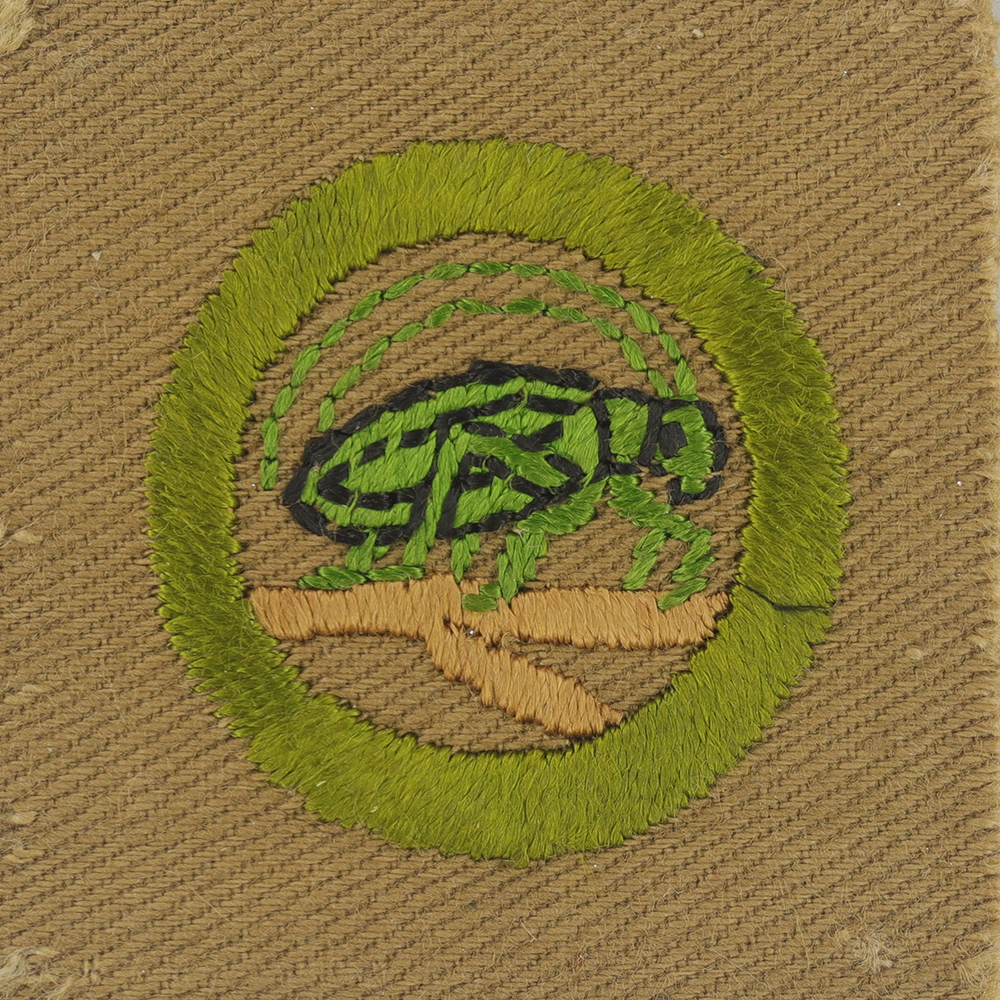
Fig. 1: InsLif-AT4-Front
- Cloth: Heavyweight tan right twill
- Embroidery: Silk continuous
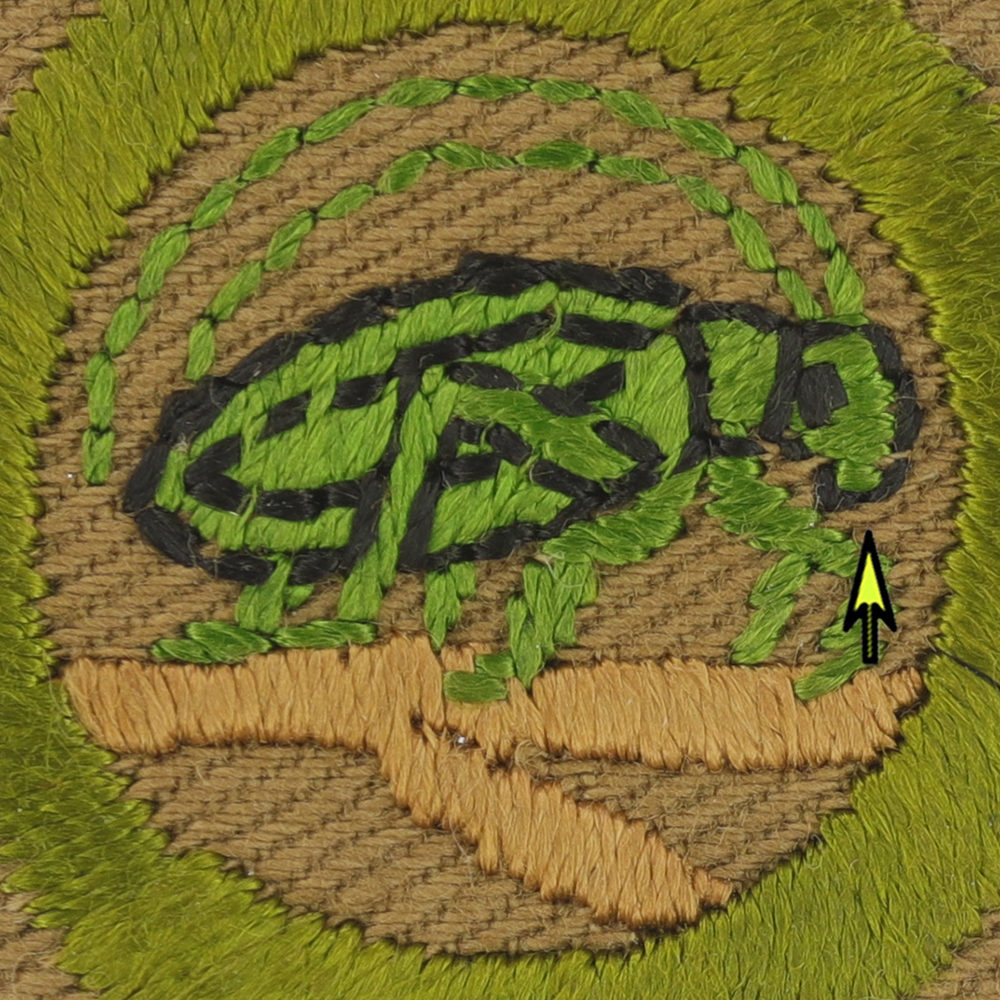
Fig. 2: InsLif-AT4-Magnified
- Design: Aphid, rounded head, rectangular neck
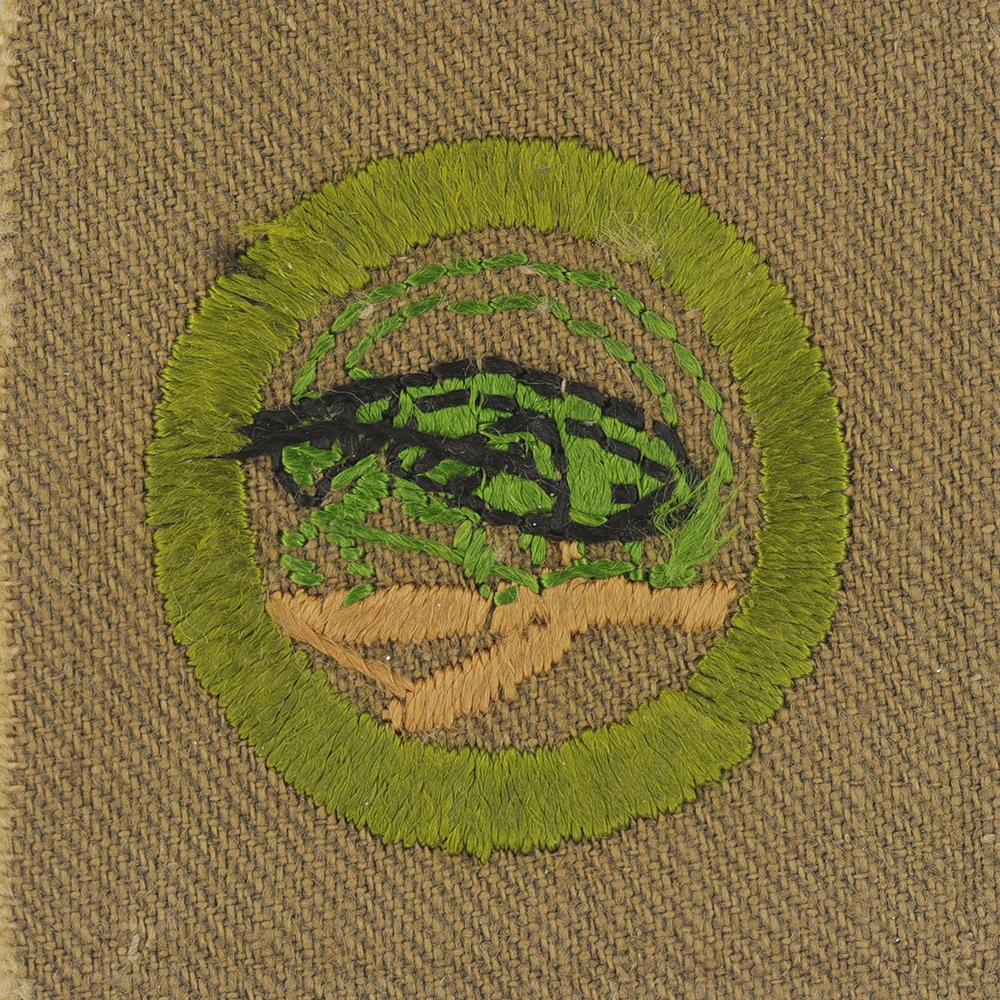
Fig. 3: InsLif-AT4-Reverse
- Back: Black imprint
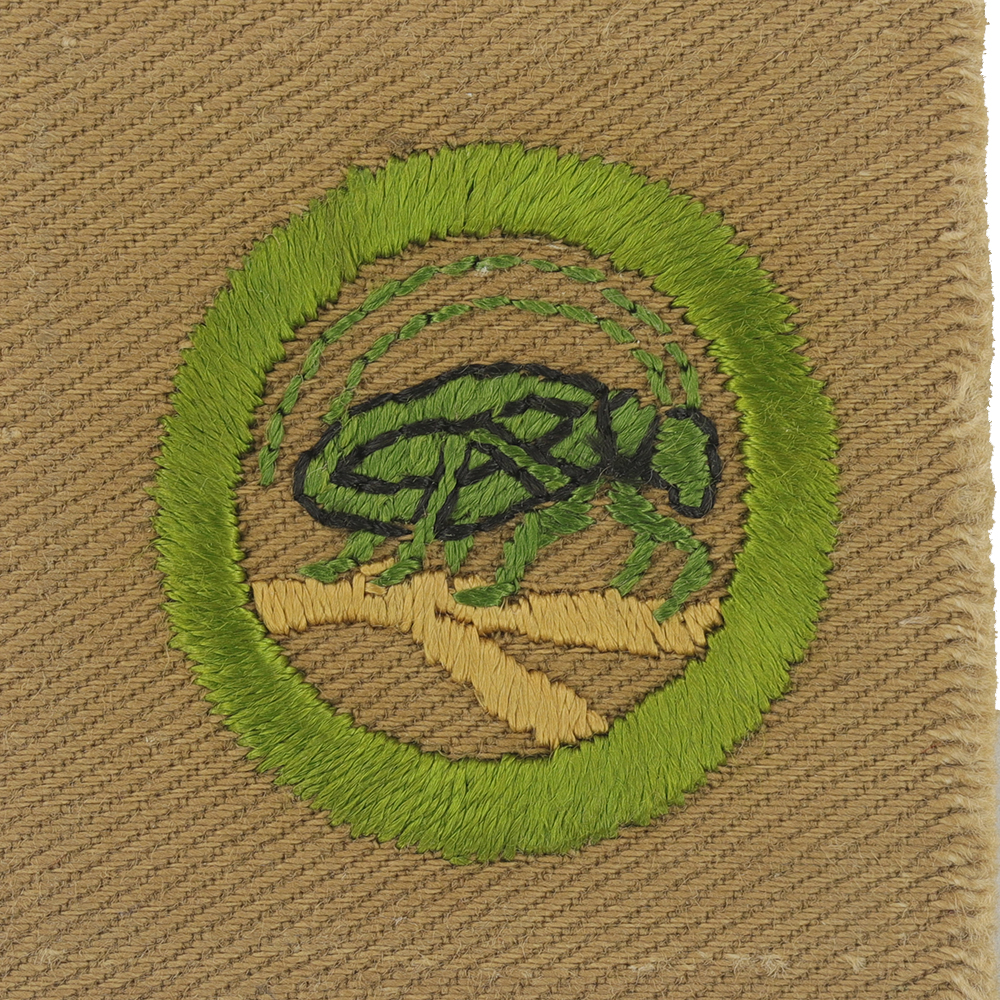
Fig. 4: InsLif-AT4-mve1-front
- Minor variation: No eye, thick highlighting
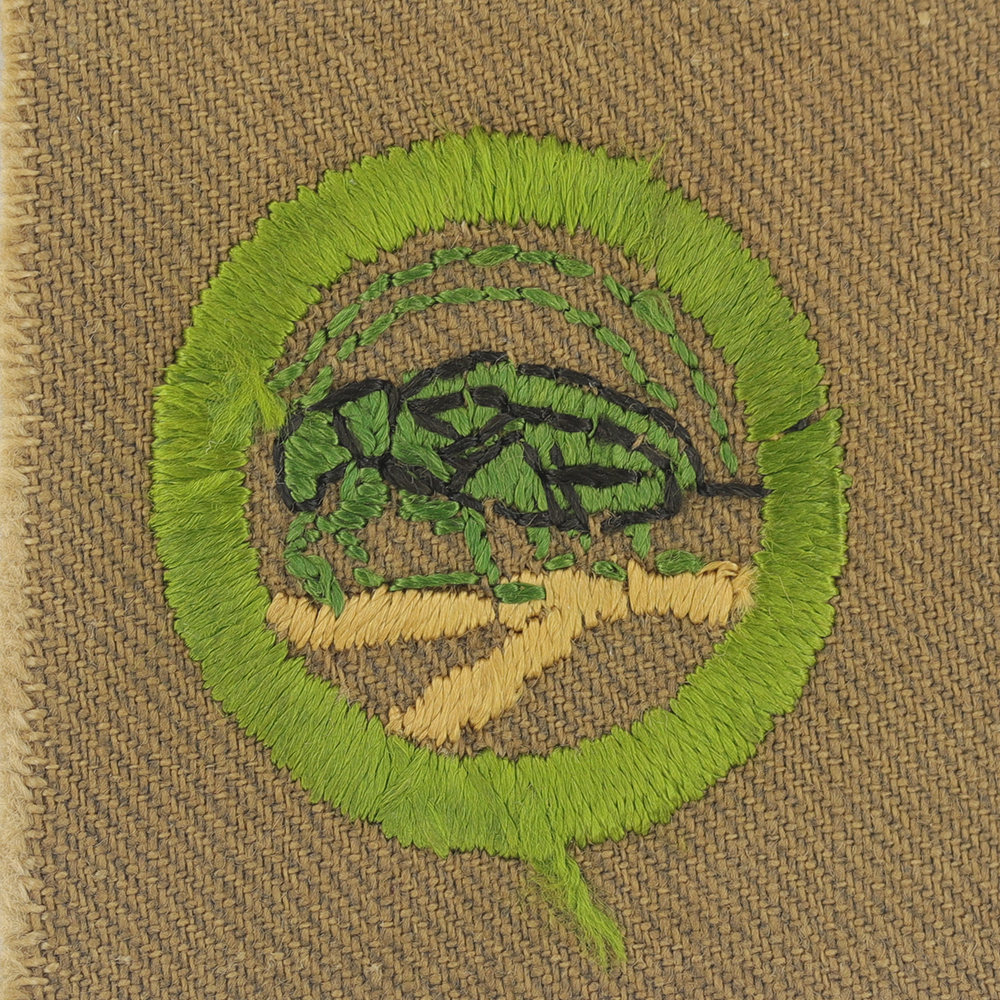
Fig. 5: InsLif-AT4-mve1-reverse
- Back: Black imprint
Item Name: Insect Life 1925 - 1933
Item ID: InsLif-AT4
Collector Rating: 1
Pamphlets Used to Earn this Badge
Requirements April 1923 until May 1925
l. Go into the country with the examiner and show to him the natural surroundings in which certain specified insects live, and shall find and demonstrate living specimens of the insects, telling something of their habits or of the nature of their fitness for life in their particular surroundings. The examiner shall ask for an insect from each of the five of the following groups without forewarning to the candidate but the scout shall have the choice of kind within each group.
1. (a) May-fly nymphs (b) caddis worms (c) anti-lion larva (doodle-bugs).
2. Larvae and pupae of mosquitos.
3. (a) Centipedes (b) scorpions (c) orb weaver spiders.
4. (a) Scale insects (b) plant lice.
5. (a) The nest of a solitary bee or wasp and its maker (mud daubers excluded) (b) bumble-bees and their nest.
6. (a) Black swimmers (b) whirligig beetles (demonstrate a peculiarity of their eyesight) (c) water striders.
7. (a) Carrion beetles (b) tumble bugs (c) leaf-beetles.
8. (a) Colony of carpenter ants or (b) of agricultural ants (c) black fly larvae (d) white ants.
9. (a) Crane-flies (b) robber-flies (c) damsel-flies and their nymphs.
10. Caterpillar of (a) cabbage butterfly (b) alfalfa butterfly (c) Monarch butterfly (d) sphinx moth (e) tiger beetles.
11. (a) Grouse locusts (b) meadow grasshoppers (c) katydids.
12. (a) Squash bugs (b) chinch bugs (c) larvae of gall wasps and their galls (d) other kinds of gall insects.
II. Make an artificial ants' nest suitable for observation and maintain a colony of ants for a period of at least two weeks. Make a record of interesting facts and habits observed. Or do the same with an observation hive of bees.
III. Make a collection of fifty species of insects. This collection will be judged upon 4 points: 1. correctness of names; 2. neatness of arrangement; 3. perfect condition of the specimens (clean, unbroken and properly mounted; 4. adherence to the following rules:
a. It is recommended that each species should be represented by two male and two female specimens when such specimens can be easily found and the sexes may be readily identified.
b. A neat written or typewritten label stating the name of the species (either common name or scientific or both to be pinned on the left on or above the row of specimens of each species.
c. The species of each family and order to be arranged together; the sequence of orders and the families to best followed in a textbook; the scientific name of each to be indicated by appropriate labels.
d. Entomological pins to be used when obtainable instead of common pins.
IV. Give evidence that he has bred through all its life stages from egg or young larvae to adult at least one species of insect. Mosquitos, blow-flies, cabbage butterflies, fruit-flies, and ants are suggested as easy species to rear.
Requirements May 1925 until September 1944
l. Go into the country with the examiner and show to him the natural surroundings in which certain specified insects live, and shall find and demonstrate living specimens of the insects, telling something of their habits or of the nature of their fitness for life in their particular surroundings. The examiner shall ask for an insect from each of the five of the following groups without forewarning to the candidate but the scout shall have the choice of kind within each group.
1. (a) May-fly nymphs (b) caddis worms (c) anti-lion larva (doodle-bugs).
2. Larvae and pupae of mosquitos.
3. (a) Centipedes (b) scorpions (c) orb weaver spiders.
4. (a) Scale insects (b) plant lice.
5. (a) The nest of a solitary bee or wasp and its maker (mud daubers excluded) (b) bumble-bees and their nest.
6. (a) Black swimmers (b) whirligig beetles (demonstrate a peculiarity of their eyesight) (c) water striders.
7. (a) Carrion beetles (b) tumble bugs (c) leaf-beetles.
8. (a) Colony of carpenter ants or (b) of agricultural ants (c) black fly larvae (d) white ants.
9. (a) Crane-flies (b) robber-flies (c) damsel-flies and their nymphs.
10. Caterpillar of (a) cabbage butterfly (b) alfalfa butterfly (c) Monarch butterfly (d) sphinx moth (e) tiger beetles.
11. (a) Grouse locusts (b) meadow grasshoppers (c) katydids.
12. (a) Squash bugs (b) chinch bugs (c) larvae of gall wasps and their galls (d) other kinds of gall insects.
II. Make an artificial ants' nest suitable for observation and maintain a colony of ants for a period of at least two weeks. Make a record of interesting facts and habits observed. Or do the same with an observation hive of bees.
III. Make a collection of fifty species of insects. This collection will be judged upon 4 points: 1. correctness of names; 2. neatness of arrangement; 3. perfect condition of the specimens (clean, unbroken and properly mounted; 4. adherence to the following rules:
a. It is recommended that each species should be represented by two male and two female specimens when such specimens can be easily found and the sexes may be readily identified.
b. A neat written or typewritten label stating the name of the species (either common name or scientific or both to be pinned on the left on or above the row of specimens of each species.
c. The species of each family and order to be arranged together; the sequence of orders and the families to best followed in a textbook; the scientific name of each to be indicated by appropriate labels.
d. Entomological pins to be used when obtainable instead of common pins.
IV. Give evidence that he has bred through all its life stages from egg or young larvae to adult at least one species of insect. Mosquitos, blow-flies, cabbage butterflies, fruit-flies, and ants are suggested as easy species to rear.

